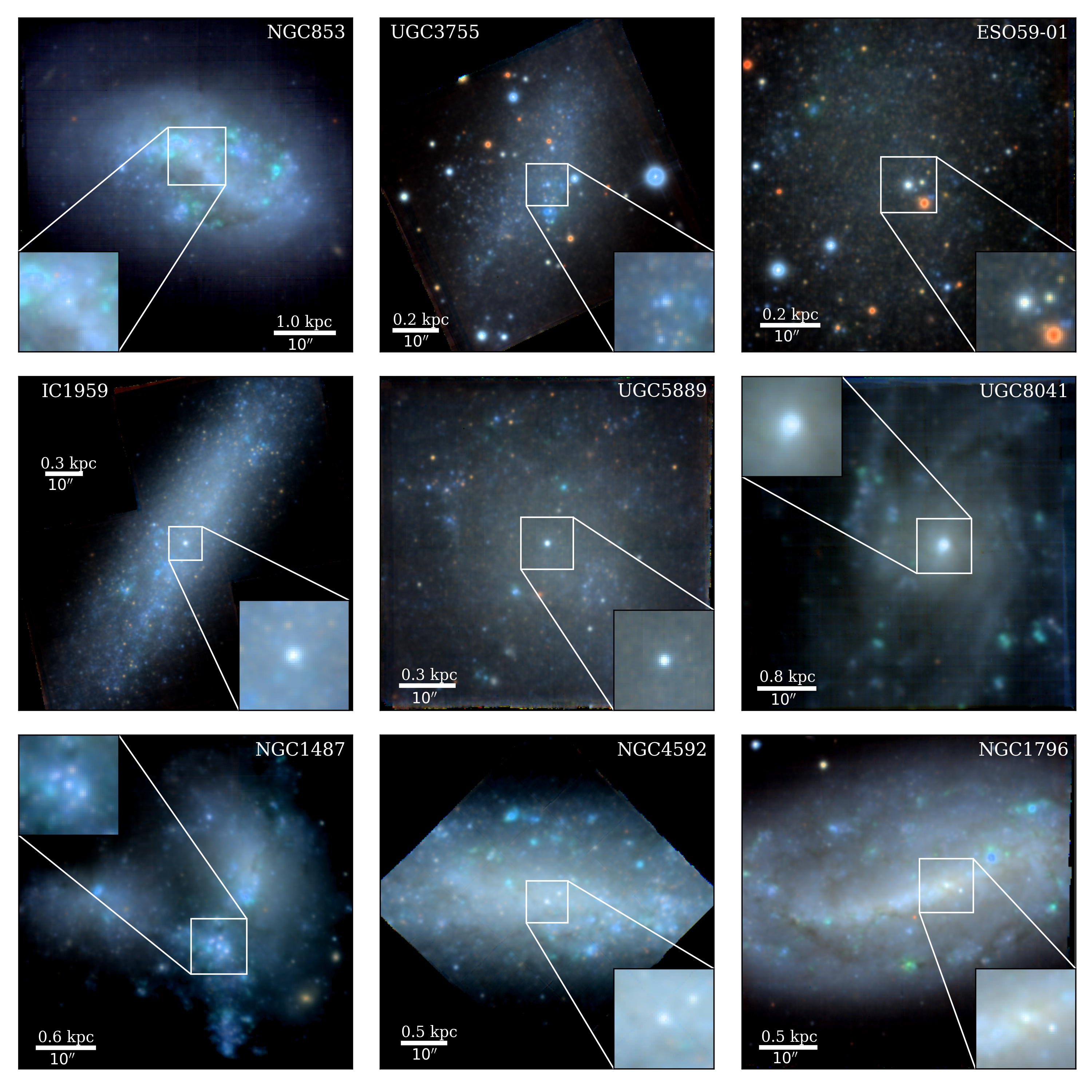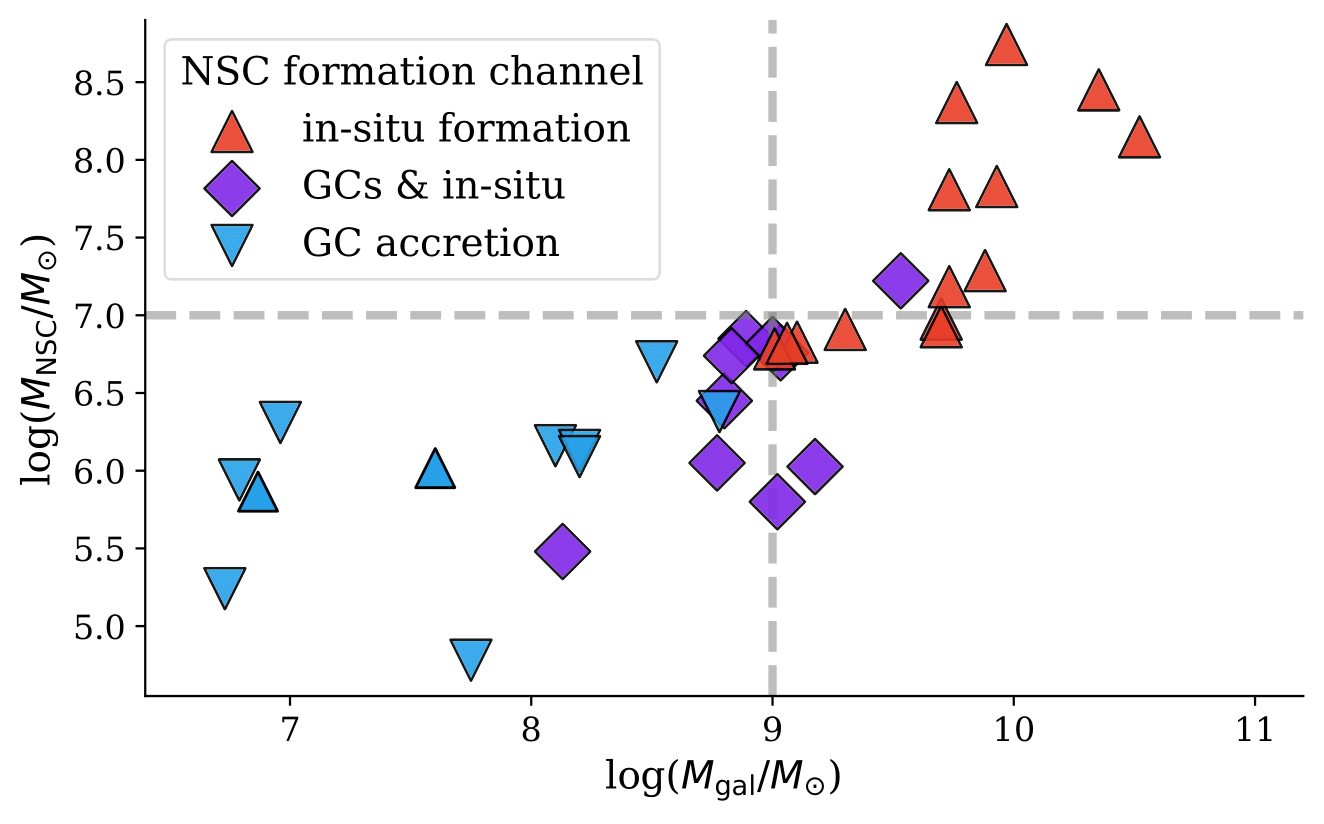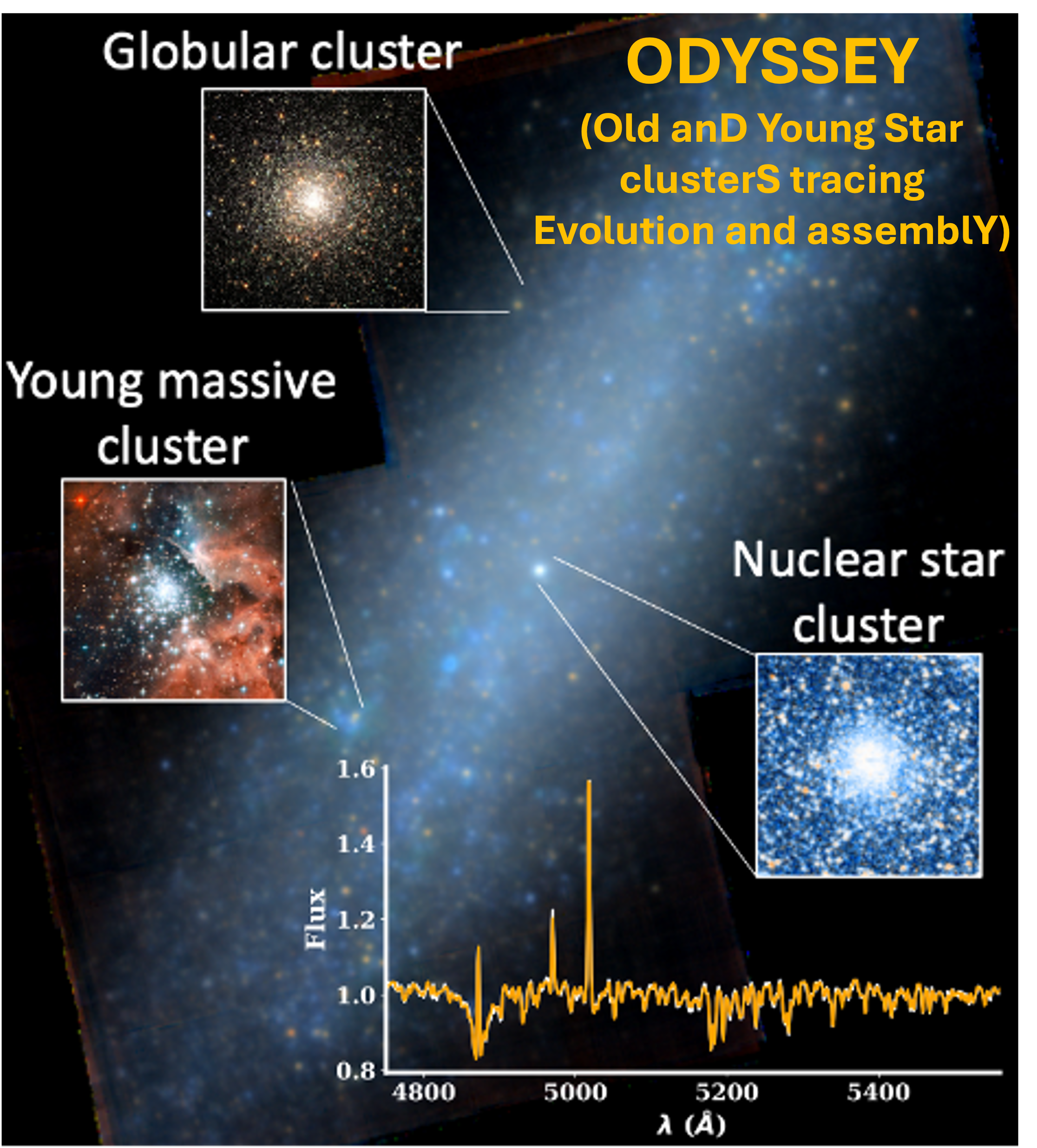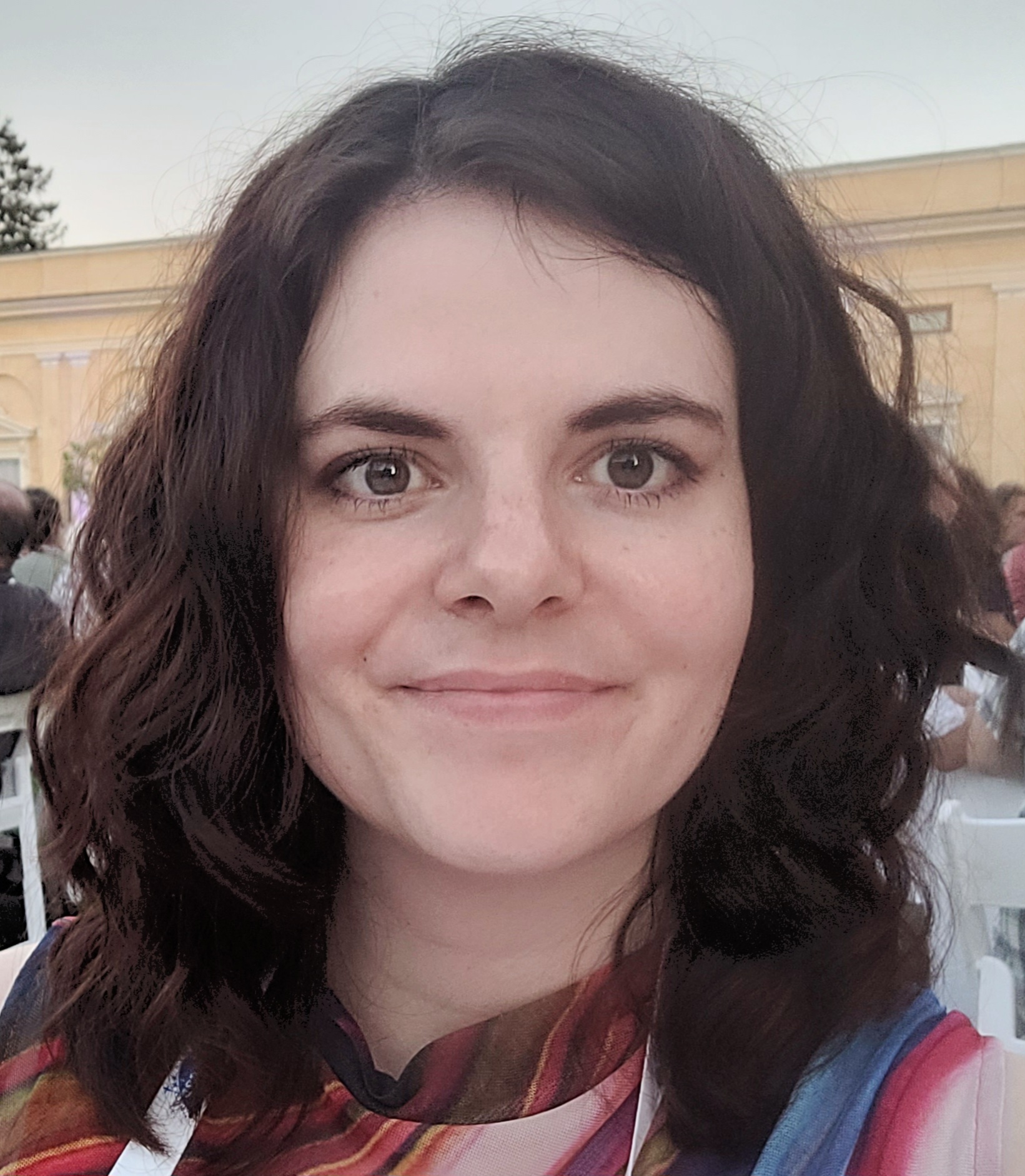About Me
I am a Marie Curie Fellow at the University of Vienna in the Department of Astrophysics, working on star clusters.
My project is Old anD Young Star clusterS tracing Evolution and assemblY (ODYSSEY).
Previously, I was a Research Fellow at the European Space Agency and a PhD student at the European Southern Observatory.
Research
I am interested in star clusters, in particular nuclear star clusters and globular clusters. Both nuclear star clusters and globular clusters are massive, dense star clusters that contain millions of stars tightly packed into a few parsecs, making them the densest stellar objects in the Universe. Globular clusters are found in basically all galaxies, from low mass dwarfs, over our own Milky Way to the most massive galaxies, but also nuclear star clusters are very common: around 70% of galaxies contain a NSC in their centre.
Nuclear star cluster formation: Generally, there are two proposed mechanisms: either nuclear star clusters form from eating up GCs that fall into the galaxy centre as a result of dynamical friction - directly connecting GCs and nuclear star clusters - or nuclear star clusters might form independently from the GCs from gas that fell into the centre. But the connection between GCs and nuclear star clusters might also work in the other direction: so-called ultra compact dwarf galaxies (UCDs) share the high stellar densities and sizes of nuclear star clusters and were proposed to be either the high-mass end of the GC population or remnant nuclear star clusters that were stripped from their host galaxy in a merger. Therefore, a GC population might also be hiding some stripped nuclear star clusters - as it has been proposed for Omega Centauri, the most massive GC in our MW.

Nuclear star cluster formation scenarios. Left: Globular cluster accretion scenario where a nuclear star cluster forms out of globular clusters that spiral into the center of a galaxy due to dynamical friction. Right: In-situ formation scenario. Here, the nuclear star cluster forms directly at the center out of gas that is undergoing star formation.
Using integral-field spectroscopy: To study nuclear star clusters and globular clusters, I use integral-field spectroscopy data from the Multi Unit Spectrscopic Explorer (MUSE), mounted at ESO's Very Large Telescope. MUSE is a great instrument because it combines imaging with spectroscopy - allowing us to study the spectra of individual star clusters alongside with the underlying host galaxy. By fitting the spectra with models, we can then infer the kinematic and chemical properties of these star clusters and how those compare to the galaxies they live in. The figure below shows nine late-type (gas-rich) dwarf galaxies that I analysed. The nuclear star clusters are highlighted in the zoom-ins.

Sample of nucleated late-type (gas-rich) dwarf galaxies.

MSCA ODYSSEY
My Marie Curie fellowship project at the University of Vienna is called "Old anD Young Star clusterS tracing Evolution and assemblY (ODYSSEY)". It is funded through the European Union's Horizon Europe programme.
In ODYSSEY, I will study massive star clusters such as globular clusters, nuclear star clusters and young massive clusters in different galactic environments, using observational data from various telescopes and instruments.

In the first part, I investigate the properties and formation histories of star clusters in dwarf galaxies, which are the building blocks of larger galaxies. This will help us understand how these systems evolve over time. I have been analysing the globular cluster system of NGC1052-DF2, a low-mass galaxy that was claimed to lack dark matter. My results show that the globular clusters in this galaxy are not as extreme as previously thought, and that the galaxy's properties are consistent with other low-mass galaxies. This suggests that NGC1052-DF2 is not an outlier, but rather a typical dwarf galaxy with a normal globular cluster system.
Moving to much more massive systems, I have focused on studying the extensive globular cluster system of the Sombrero galaxy (M104), a massive galaxy with a prominent bulge and metal-rich halo. By analysing the kinematics and metallicities of the globular clusters, we aim to trace the assembly history of this galaxy. Additionally, we used the relation between globular cluster luminosities and velocity dispersions to measure the distance to Sombrero, finding a value consistent with other distance measurements.
First Author Publications
The full list of my publications can be found at the ADS or check my ORCID page.
"Distance measurements from the internal dynamics of globular clusters: Application to the Sombrero galaxy (M 104)"
K. Fahrion, M. A. Beasley, A. Gvozdenko, G. van de Ven, K. L. Rhode, A. L. Chies-Santos, A. Ferre-Mateu, M. Rejkuba, O. Müller, E. Emsellem
2025, submitted to OJA
"Globular clusters in M104: Tracing kinematics and metallicities from the centre to the halo"
K. Fahrion, M. A. Beasley, E. Emsellem, A. Gvozdenko, O. Müller, M. Rejkuba, A. L. Chies-Santos
2025, A&A in press
"Revisiting the globular clusters of NGC1052-DF2"
K. Fahrion, M. A. Beasley, A. Gvozdenko, S. Arencibia Guerra, T. Jerabkova, J. Fensch, E. Emsellem
2025, A&A, 697, 145
"Growing a nuclear star cluster from star formation and cluster mergers: The JWST NIRSpec view of NGC 4654"
K. Fahrion, T. Böker, M. Perna, T. L. Beck, R. Maiolino, S. Arribas, A. J. Bunker, S. Charlot, M. Ceci, G. Cresci, G. De Marchi, N. Lützgendorf
L. Ulivi
2024, A&A, 687, 83
"The hierarchical formation of 30 Doradus as seen by JWST"
K. Fahrion & G. De Marchi
2024, A&A, 681, 20
"Extending the extinction law in 30 Doradus to the infrared with JWST"
K. Fahrion & G. De Marchi
2023, A&A, 671, 14
"Nuclear star cluster formation in star-forming dwarf galaxies"
K. Fahrion, T.-E. Bulichi, M. Hilker, R. Leaman, M. Lyubenova, O. Müller, N. Neumayer, F. Pinna, M. Rejkuba, G. van de Ven
2022, A&A, 667, 101
"Evaluating the feasibility of interpretable machine learning for globular cluster detection"
D. Dold & K. Fahrion
2022, A&A, 663, A81, A81.
"Disentangling the formation mechanisms of nuclear star clusters"
K. Fahrion, R. Leaman, M. Lyubenova, G. van de Ven
2022, A&A, 658, 172
"Diversity of nuclear star cluster formation mechanisms revealed by their star formation histories"
K. Fahrion, M. Lyubenova, G. van de Ven, M. Hilker, R. Leaman, J. Falcón-Barroso, A. Bittner, L. Coccato, E. M. Corsini, D. A. Gadotti, E. Iodice, R. M. McDermid, I. Martín-Navarro, F. Pinna, A. Poci, M. Sarzi, P. T. de Zeeuw, L. Zhu
2021, A&A, 650, 137
"The Fornax 3D project: Non-linear colour-metallicity relation of globular clusters"
K. Fahrion, M. Lyubenova, M. Hilker, G. van de Ven, J. Falcón-Barroso, R. Leaman, I. Martín-Navarro, A. Bittner, L. Coccato, E. M. Corsini, D. A. Gadotti, E. Iodice, R. M. McDermid, F. Pinna, M. Sarzi, S. Viaene, P. T. de Zeeuw, L. Zhu
2020, A&A, 637, A27
"The Fornax 3D project: Globular clusters tracing kinematics and metallicities"
K. Fahrion, M. Lyubenova, M. Hilker, G. van de Ven, J. Falcón-Barroso, R. Leaman, I. Martín-Navarro, A. Bittner, L. Coccato, E. M. Corsini, D. A. Gadotti, E. Iodice, R. M. McDermid, F. Pinna, M. Sarzi, S. Viaene, P. T. de Zeeuw, L. Zhu
2020, A&A, 637, A26
"Metal-poor nuclear star clusters in two dwarf galaxies near Centaurus A suggesting formation from the in-spiraling of globular clusters"
K. Fahrion, O. Müller, M. Rejkuba, M. Hilker, M. Lyubenova, G. van de Ven, I. Georgiev, F. Lelli, M. S. Pawlowski, H. Jerjen
2020, A&A, 634, A53
"Constraining nuclear star cluster formation using MUSE-AO observations of the early-type galaxy FCC47"
K. Fahrion, M. Lyubenova, G. van de Ven, R. Leaman, M. Hilker, I. Martin-Navarro, L. Zhu, M. Alfaro-Cuello, L. Coccato, E. M. Corsini,
J. Falcon-Barroso, E. Iodice, R. M. McDermid, M. Sarzi, T. de Zeeuw
2019, A&A, 628, A92
"Single metal-poor ultra compact dwarf galaxy at one kiloparsec distance from the low-mass elliptical galaxy FCC47"
K. Fahrion, I. Georgiev, M. Hilker, M. Lyubenova, G. van de Ven, M. Alfaro-Cuello, E. M. Corsini, M. Sarzi, R. M. McDermid, T. de Zeeuw
2019, A&A, 625, A50
"Disentangling the ISM phases of the dwarf galaxy NGC 4214 using [C II] SOFIA/GREAT observations"
K. Fahrion, D. Cormier, F. Bigiel, S. Hony, N. P. Abel, P. Cigan, T. Csengeri, U. U. Graf, V. Lebouteiller, S. C. Madden, R. Wu, L. Young
2017, A&A, 599, A9
Curriculum Vitae
Research positions
Since 09/2024:
Marie Curie Fellow
University of Vienna, Department of Astrophysics
10/2021 - 08/2024:
Internal Research Fellow
European Space Agency, Noordwijk, the Netherlands
09/2018 - 08/2021:
PhD Research Fellow
European Southern Observatory, Garching, Germany
Education
09/2018 - 08/2021:
PhD in Astronomy , graduated summa cum laude
Thesis: "The Build-up of Galactic Stellar Nuclei" ( available here. ) conducted at
European Southern Observatory, Garching, Germany
Ludwig-Maximilians University Munich, Germany
Supervisor: Dr. Maryia Lyubenova
04/2016 - 07/2018:
Master of Science in Physics
Ruprecht-Karls-Universität Heidelberg, Germany
Thesis: "Globular Cluster Systems and the Connection to Nuclear Star Cluster Formation"
10/2012 - 04/2016:
Bachelor of Science in Physics
Ruprecht-Karls-Universität Heidelberg, Germany
Thesis: "Deciphering Star Formation at low Metallicity - New SOFIA Observations of the Dwarf Galaxy NGC4214"
Invited Talks
2024:
"Hiding in your MUSE data: Nuclear star clusters and globular clusters"
ESO Workshop: A decade with MUSE and beyond.
2023:
"Nuclear star cluster formation in the context of galaxy evolution"
Joint UniGE-EPFL Astronomy Colloquium, Geneva, Switzerland.
2023:
"Nuclear star cluster formation in dwarf and massive galaxies"
Helsinki Astrophysics Seminar, Helsinki, Finland.
2023:
"Nuclear star cluster formation in the context of galaxy evolution"
EAS Annual Meeting 2023, Session SS28 "Understanding the connection between nuclear star clusters, black holes and galaxy evolution",
Krakow, Poland.
2023:
"IMBH formation in nuclear star clusters"
EAS Annual Meeting 2023, Symposium S12 "Breaking down the AGN frontiers: light and sound from early black holes",
Krakow, Poland.
2022:
"How do nuclear star clusters form in different galaxies?"
KT Boost Workshop, AIP Potsdam, Germany.
2022:
"Deciphering the formation of nuclear star clusters"
DAO Herzberg Astronomy Colloquium, National Research Council of Canada.
2022:
"The Formation of Nuclear Star Clusters"
Radboud Astrophysics Colloquium, Radboud University Nijmegen.
2021:
"The Formation of Nuclear Star Clusters"
CfA Seminar, Center for Astrophysics, Harvard \& Smithsonian.
2021:
"How do nuclear star clusters form?"
Chalmers Astrophysics Colloquium, Chalmers, Goteborg
Recent Conference Talks
2025:
"New ways of looking at old clusters: high-resolution spectroscopy for distance measurements"
Bridging scales 2025, Matera, Italy.
2025:
"New ways of working with old clusters"
Focusing strong lenses: star clusters and globular cluster progenitors at high redshift, Sexten, Italy.
2024:
"Distances to globular cluster-rich UDGs: The case of NGC1052-DF2"
EAS Annual Meeting 2024, Padova, Italy.
2024:
"Understanding the growth of galaxy nuclei from nuclear star clusters"
Alpbach workshop on clouds, star clusters & black holes, Alpbach, Austria.
2023:
"Unveiling nuclear star cluster formation with stellar population analysis"
A life devoted to stellar populations, Puerto de la Cruz, Tenerife, Spain.
2023:
"Nuclear star cluster formation in the context of galaxy evolution and star cluster systems"
MODEST-23, Evanston, IL, USA.
2023:
"Globular cluster systems with MUSE: How good are globular clusters as tracers of galaxy properties?"
EAS Annual Meeting 2023, Session SS10 "The edge of galaxies from field to cluster environment: the build-p of stellar haloes",
Krakow, Poland.
2022:
"Nuclear star cluster formation in dwarf galaxies"
Origin, growth and feedback of black holes in dwarf galaxies, San Sebastian, Spain.
2022:
"Globular cluster systems viewed with MUSE as tracers of galaxy assembly"
Aspen Winter Conference: Globular Clusters.
Skills
Languages:
German: native
English: fluent
French: beginner
Programming: experienced with python, beginner in IDL & C++
Data analysis: imfit, pPXF, iraf
Technical skills: LaTex, MS Office, Inkscape, Gimp
Basic data reduction with MUSE, ERIS, SINFONI, FLAMES esoreflex pipeline + ZAP, JWST NIRCam
Observational experience: with the Atacama Pathfinder EXperiment (APEX) submilimeter telescope (two week observing shift)
Teaching & Outreach
2025 Topic Seminar for Master and PhD students, "Globular clusters on different scales", University of Vienna
Nature News & Views article "Ultra-compact oddities are galaxies stripped of stars"
Faszination Astronomie Online: Sternhaufen - Fossilien der Galaxienentwicklung
ESO blog: Astronomer on tour - The story of a trip to Chile to observe with the APEX telescope
09/2018 - present: Tour guide at ESO supernova
2017: Teaching assistant "Introduction into Astronomy and Astrophysics II", University Heidelberg
2016: Teaching assistant "Introduction into Astronomy and Astrophysics I", University Heidelberg
2014: Teaching assistant "Beginner's Lab Course in Physics", University Heidelberg
Courses and Training
December 2023: Tools to challenge unacceptable behaviour - Active Bystander Training, training at ESA
November 2023: Overcoming hurdles in academia, training at ESA
January 2023: Managing upwards, training at ESA
November 2022: Mentoring training, ESA
November 2020: Physics of the Cosmic Microwave Background, IMPRS advanced course
October 2020: Stellar populations, IMPRS advanced course
March 2020: Galaxy formation, IMPRS advanced course
January 2020: Astrobiology, IMPRS advanced course
November 2019: Cosmic structure formation, IMPRS advanced course
April 2019: Third ASTERICS-OBELICS International School, advanced software programming for astrophysics and astroparticle physics
April 2019: Communication Skills Training at European Southern Observatory
February 2019: Astrophysics of black holes, IMPRS advanced course
January 2019: High resolution astrophysics, IMPRS advanced course
November 2018: Training Session: Avoiding and challenging harassment at European Southern Observatory
